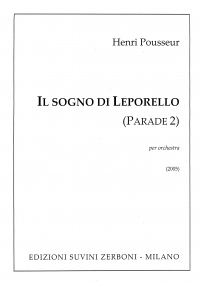Studies in Green Textures: II. Echoing
for piano
5,00 €
Digital version (+0,00 €) instant download
Printed format (+14,80 € printing and shipping). Colissimo7-14 days aprox.
When you buy a score, you can contact the composer right here!
Specifications
Region
Europe
Date
2014
Estimated Duration
1 - 5min
ISMN : 979-0-2325-2093-3
Notes on this piece Echoing
Study no 2 from Studies in Green Textures
Studies in Green Textures
The characteristic of the piano that has always interested me the most, and which in my opinion represents its quintessence, is its ability to produce complex and elusive textures. To me, this particularity of piano writing has remained somewhat mysterious and it spontaneously awakens in me the strongest and richest synaesthetic sensations. The Studies in Green Textures explore some of these dense sound-colour textures, making use of multiple idiomatic instrumental techniques.
One aspect of textures that particularly fascinates me is the play with the perception of the performer and listener. When sounds are moving too fast for it to be possible to follow their individual paths, the perception tends to focus on the overall sound phenomenon. But the listener and the performer can constantly filter the flow of moving sounds and extract fragments from it, briefly chasing elusive details. Fragments of phrases fleetingly catch the attention only to plunge back into the stream, disappearing to let other elements immediately appear.
This continuous movement from the whole to the details and vice versa, this relentless navigation within the texture, gives rise to the illusion of multiple simultaneous sound layers that are never fully revealed.
Echoing
The second etude, Echoing, is articulated on three sound layers: an extremely mobile texture – softly executed by the two hands as a rustling background – made up of a superimposition of fifths that progressively extend over all the registers of the piano; long sounds in the right hand that form throughout the study five phrases stretched in time; and finally, the “traces” that these foreground sounds leave on the texture, perturbing its uniformity.
The texture in the background turns out to be an “elastic” element that reacts to the slow notes of the melody, echoing and reverberating them, only to return to its initial state of equilibrium.
Filippo Zapponi
Add to a playlist
- Login to create your own lists
Study no 2 from Studies in Green Textures
Studies in Green Textures
The characteristic of the piano that has always interested me the most, and which in my opinion represents its quintessence, is its ability to produce complex and elusive textures. To me, this particularity of piano writing has remained somewhat mysterious and it spontaneously awakens in me the strongest and richest synaesthetic sensations. The Studies in Green Textures explore some of these dense sound-colour textures, making use of multiple idiomatic instrumental techniques.
One aspect of textures that particularly fascinates me is the play with the perception of the performer and listener. When sounds are moving too fast for it to be possible to follow their individual paths, the perception tends to focus on the overall sound phenomenon. But the listener and the performer can constantly filter the flow of moving sounds and extract fragments from it, briefly chasing elusive details. Fragments of phrases fleetingly catch the attention only to plunge back into the stream, disappearing to let other elements immediately appear.
This continuous movement from the whole to the details and vice versa, this relentless navigation within the texture, gives rise to the illusion of multiple simultaneous sound layers that are never fully revealed.
Echoing
The second etude, Echoing, is articulated on three sound layers: an extremely mobile texture – softly executed by the two hands as a rustling background – made up of a superimposition of fifths that progressively extend over all the registers of the piano; long sounds in the right hand that form throughout the study five phrases stretched in time; and finally, the “traces” that these foreground sounds leave on the texture, perturbing its uniformity.
The texture in the background turns out to be an “elastic” element that reacts to the slow notes of the melody, echoing and reverberating them, only to return to its initial state of equilibrium.
Filippo Zapponi
Instrumentation
Piano
Score Details
Format - A3 / Tabloid
Pages - 22
Pages - 22
Recording
Simulation on a virtual piano











 a3 z 3 1-77_285x285.png)



